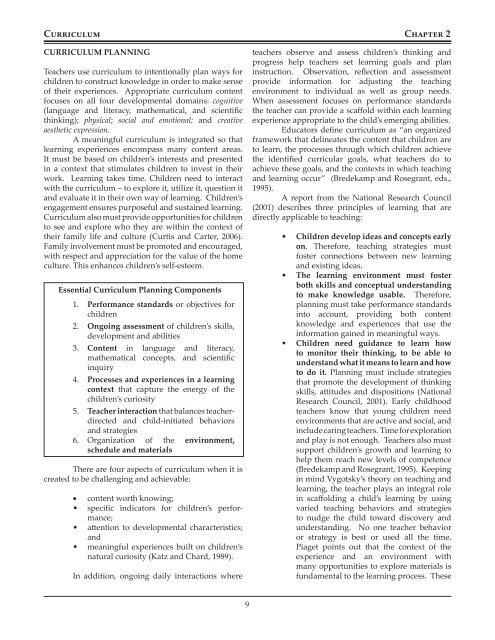Early Childhood
Early Childhood
Early Childhood
Create successful ePaper yourself
Turn your PDF publications into a flip-book with our unique Google optimized e-Paper software.
Curriculum Chapter 2<br />
CURRICULUM PLANNING<br />
Teachers use curriculum to intentionally plan ways for<br />
children to construct knowledge in order to make sense<br />
of their experiences. Appropriate curriculum content<br />
focuses on all four developmental domains: cognitive<br />
(language and literacy, mathematical, and scientific<br />
thinking); physical; social and emotional; and creative<br />
aesthetic expression.<br />
A meaningful curriculum is integrated so that<br />
learning experiences encompass many content areas.<br />
It must be based on children’s interests and presented<br />
in a context that stimulates children to invest in their<br />
work. Learning takes time. Children need to interact<br />
with the curriculum – to explore it, utilize it, question it<br />
and evaluate it in their own way of learning. Children’s<br />
engagement ensures purposeful and sustained learning.<br />
Curriculum also must provide opportunities for children<br />
to see and explore who they are within the context of<br />
their family life and culture (Curtis and Carter, 2006).<br />
Family involvement must be promoted and encouraged,<br />
with respect and appreciation for the value of the home<br />
culture. This enhances children’s self-esteem.<br />
Essential Curriculum Planning Components<br />
1. Performance standards or objectives for<br />
children<br />
2. Ongoing assessment of children’s skills,<br />
development and abilities<br />
3. Content in language and literacy,<br />
mathematical concepts, and scientific<br />
inquiry<br />
4. Processes and experiences in a learning<br />
context that capture the energy of the<br />
children’s curiosity<br />
5. Teacher interaction that balances teacherdirected<br />
and child-initiated behaviors<br />
and strategies<br />
6. Organization of the environment,<br />
schedule and materials<br />
There are four aspects of curriculum when it is<br />
created to be challenging and achievable:<br />
• content worth knowing;<br />
• specific indicators for children’s performance;<br />
• attention to developmental characteristics;<br />
and<br />
• meaningful experiences built on children’s<br />
natural curiosity (Katz and Chard, 1989).<br />
In addition, ongoing daily interactions where<br />
9<br />
teachers observe and assess children’s thinking and<br />
progress help teachers set learning goals and plan<br />
instruction. Observation, reflection and assessment<br />
provide information for adjusting the teaching<br />
environment to individual as well as group needs.<br />
When assessment focuses on performance standards<br />
the teacher can provide a scaffold within each learning<br />
experience appropriate to the child’s emerging abilities.<br />
Educators define curriculum as “an organized<br />
framework that delineates the content that children are<br />
to learn, the processes through which children achieve<br />
the identified curricular goals, what teachers do to<br />
achieve these goals, and the contexts in which teaching<br />
and learning occur” (Bredekamp and Rosegrant, eds.,<br />
1995).<br />
A report from the National Research Council<br />
(2001) describes three principles of learning that are<br />
directly applicable to teaching:<br />
• Children develop ideas and concepts early<br />
on. Therefore, teaching strategies must<br />
foster connections between new learning<br />
and existing ideas.<br />
• The learning environment must foster<br />
both skills and conceptual understanding<br />
to make knowledge usable. Therefore,<br />
planning must take performance standards<br />
into account, providing both content<br />
knowledge and experiences that use the<br />
information gained in meaningful ways.<br />
• Children need guidance to learn how<br />
to monitor their thinking, to be able to<br />
understand what it means to learn and how<br />
to do it. Planning must include strategies<br />
that promote the development of thinking<br />
skills, attitudes and dispositions (National<br />
Research Council, 2001). <strong>Early</strong> childhood<br />
teachers know that young children need<br />
environments that are active and social, and<br />
includecaringteachers. Timeforexploration<br />
and play is not enough. Teachers also must<br />
support children’s growth and learning to<br />
help them reach new levels of competence<br />
(Bredekamp and Rosegrant, 1995). Keeping<br />
in mind Vygotsky’s theory on teaching and<br />
learning, the teacher plays an integral role<br />
in scaffolding a child’s learning by using<br />
varied teaching behaviors and strategies<br />
to nudge the child toward discovery and<br />
understanding. No one teacher behavior<br />
or strategy is best or used all the time.<br />
Piaget points out that the context of the<br />
experience and an environment with<br />
many opportunities to explore materials is<br />
fundamental to the learning process. These


